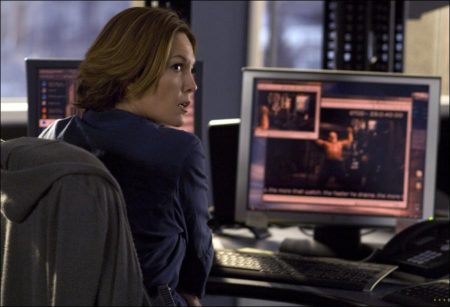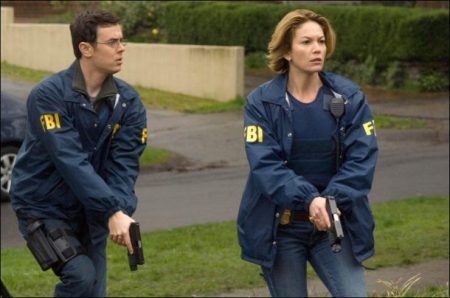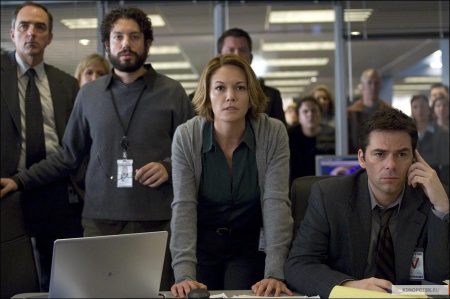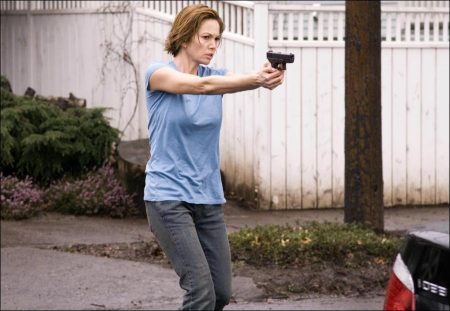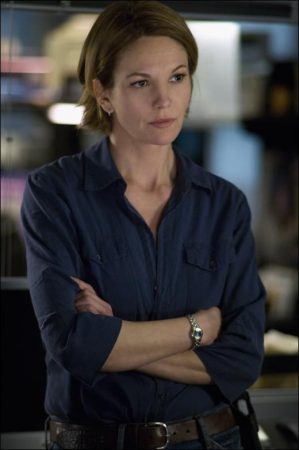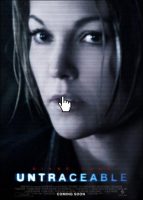Tagline: A cyber killer has finally found the perfect accomplice: You.
Untraceable movie storyline. Special Agent Jennifer Marsh (Diane Lane) works in an elite division of the FBI dedicated to fighting cybercrime. She thinks she has seen it all, until a particularly sadistic criminal arises on the Internet. This tech-savvy killer posts live feeds of his crimes on his website; the more hits the site gets, the faster the victim dies. Marsh and her team must find the elusive killer before time runs out. Within the FBI, there exists a division dedicated to investigating and prosecuting criminals on the internet. Welcome to the front lines of the war on cybercrime, where Special Agent Jennifer Marsh (Diane Lane) has seen it all… until now.
A tech-savvy internet predator is displaying his graphic murders on his own website — and the fate of each of his tormented captives is left in the hands of the public: the more hits his site gets, the faster his victims die. When this game of cat and mouse becomes personal, Marsh and her team must race against the clock to track down this technical mastermind who is virtually untraceable.
Untraceable is a 2008 American thriller film starring Diane Lane, Colin Hanks, Billy Burke, and Joseph Cross. It was directed by Gregory Hoblit and distributed by Screen Gems. Set in Portland, Oregon, the film involves a serial killer who rigs contraptions that kill his victims based on the number of hits received by a website KillWithMe.com that features a live streaming video of the victim. Millions of people log on, hastening the victims’ deaths.
A Delicate Balance Between Life and Job
FBI Special Agent Jennifer Marsh (Diane Lane) works hard to maintain a delicate balance between her life as a single mother and her job as a law enforcement officer. Each night, she trolls the Internet with her partner Griffin Dowd (Colin Hanks), cracking down on credit card fraud and sexual predators from the bureau’s Portland, Oregon field office. When they receive a tip regarding a creepy new website, the partners begin to monitor killwithme.com in an effort to determine its authenticity.
At first the site seems too outrageous to be real. The creator has stranded a kitten on a sticky rat trap and is calling on his viewers to spread the word as the cat slowly dies on camera. An intense internet search reveals an intricate web of servers and hosts that make the website virtually untraceable, but reveals that the killer is taunting the agents with clues that all point to Portland. When a local man is kidnapped and takes the kitten’s place, an even more frightening scenario unfolds: An online readout indicates how many users are logged on-the more people who visit the site, the sooner the man will die. Unable to stop more and more visitors from clicking on the site, the agents must watch in horror as the counter reaches the fatal number.
Marsh is drafted to investigate the case as part of a multi-agency task force with Portland Police Detective Eric Box (Billy Burke). As the killer’s crimes escalate and Marsh turns her considerable talents to finding him, she grows increasingly distracted from her family, unaware of a looming threat to her loved ones. As the task force gets closer to their quarry, the killer tightens an invisible noose that draws Marsh’s FBI partner into his deadly scenario. With time running out, Marsh and Box begin to untangle the intricate web of clues and interconnections, but the solution may come too late.
About the Production
When producers Tom Rosenberg and Gary Lucchesi first read the script by Robert Fyvolent and Mark Brinker that would eventually become Untraceable, the timeliness of its story made it irresistible. “The cyber-crime unit of the FBI is relatively new,” says Lucchesi. “It was established just six or seven years ago. Untraceable focuses on a case that is unusual because it doesn’t deal with child abuse or credit card theft. It deals with somebody who’s actually committing a murder and using the Internet to facilitate it. The public is watching and the more people who tune in, the faster the victim dies.”
While the Internet is a fount of useful information and entertainment, its anonymity gives it the potential to stoke unhealthy curiosity, says Lucchesi. “A lot of us open up our computers and look at the news, but at least as many look at the gossip: Which young movie star got arrested last night or has gone after a photographer or is having sex with somebody he or she shouldn’t? We’ve become a public that’s fueled by Internet information. One of the things that the movie asks us is, if a violent crime was being committed, would you watch it? Would you watch it if no one knew?”
To develop the script, Rosenberg and Lucchesi, who are chairman and president, respectively, of Lakeshore Entertainment, brought in screenwriter Allison Burnett, with whom they had worked on Lakeshore’s Feast of Love starring Morgan Freeman, Greg Kinnear and Radha Mitchell.
“Allison is more of a dramatic writer, but we thought his understanding of characters would work really well for this thriller,” Lucchesi says. “He’s very forthcoming with ideas and quick in terms of execution. He knocked it out of the park.”
Together, the producers and Burnett focused on creating the story’s main characters and the relationships between them-while also working hard to make sure the film remained in the realm of the technologically possible.
“It was very much a collaboration,” says Lucchesi. “The two of us sat with him and went through the screenplay page by page.” During this phase, Burnett added a complex and convincing back story for the murderer and fleshed out the central character of Jennifer Marsh, the role that Diane Lane would play.
Satisfied the script was ready for the big screen, Rosenberg and Lucchesi turned their attention to finding the right director to bring it to life. They sent the script to Gregory Hoblit and his frequent collaborator, producer Howard “Hawk” Koch, Jr., who most recently teamed up on the thriller Fractured, starring Anthony Hopkins and Ryan Gosling. Hoblit’s impressive résumé also includes the feature Primal Fear, as well as episodes of television series “NYPD Blue” and “Hill Street Blues.”
Once he read the screenplay, Hoblit immediately knew he wanted to tackle the film. “The script takes a look at a whole new world,” says the director. “Cyber-crime came to become a vital unit within the FBI only a few years ago. Now there’s an entire floor dedicated to nothing but cyber-crime in the Federal Building in Portland.”
Hoblit’s meticulous attention to detail made him an ideal choice for the movie, says Koch. “If you’re going to do a movie about cyber detectives, then you better know your subject matter. We really investigated the technical stuff so hopefully all the cyber geeks out there will appreciate its authenticity.”
During the years he worked as a director and producer on the television series “NYPD Blue” and “Hill Street Blues,” Hoblit consulted extensively with police officers to make sure he accurately depicted the world of law enforcement. “He’s a big one for verisimilitude,” says his long-time producer, Koch. “He always appreciated getting phone calls or e-mails or letters from police officers afterwards saying, `You really got it right.'”
So when Hoblit tackled a project about the FBI’s new cybercrime unit, he brought in numerous experts, including the Portland police and FBI officials in Los Angeles and Portland.
“The Bureau vetted the script and helped with some of the technical details,” says Koch, “because one of the things we were very much focused on was how does one create a truly untraceable site, a site that can’t be shut down? They helped make sure that we got the technology right.”
“Our key advisor from the FBI was Special Agent E.J. Hilbert,” says Gary Lucchesi “At that time, Hilbert was a Cyber Agent, specializing in computer intrusions and subsequent computer fraud for the bureau. He has since gone on to work in security for MySpace.”
In addition, Jane Brilheart, a Special Agent who has been with the Bureau for 20 years, worked closely with the film’s star Diane Lane to help her understand the job. Like Jennifer Marsh, Brilheart works in the cyber-crime division. “I go online as a 13 or 14-year-old girl and try to catch the individuals that are sexually exploiting children.”
Being able to work with a real life cyber-cop gave Diane Lane the opportunity to get to know not just the professional FBI agent, but to explore the pressures the job puts on her personal life. “That’s what I really wanted to talk to her about,” she says. “What can I use from all this to take home in my real life? It was very interesting. I’ve told my daughter that I can see everything she ever does, and everybody can always see anything anybody ever does on the computer.”
Lane dedicated a great deal of time and energy to learning the details of the job, says Brilheart. “She came into our office to see me go online. She was interested in finding out the little things. You know, do you carry your gun every place? How do you track down an IP address? She had some great questions.”
Lane was also interested in how Brilheart found balance between her life as an agent and her role as a mother. “There are times when it is a hard thing to handle,” Brilheart says. “I explained to her that with your kids you tend talk about some of the dangers, but you also have to remember that, kids being kids, they need a mom, and you have to step back and shed your law enforcement life to be with them.”
All of the actors were appreciative of the opportunity to see real agents at work. “That to me has been sort of the most fascinating part of the whole experience, meeting the people that actually patrol the Internet for a living,” says Colin Hanks. “It’s extremely hard work that they do-I can see the toll that it takes, but I can also see the reward. That was more interesting than the firearms training we did, or learning how to storm a house, or any of those things.”
The filmmakers also brought in Phil Blanchard, a police technical advisor. “It’s my job to see to it that I can create it as realistic as possible for the director,”
Blanchard says. “I would say there’s a little cinematic license, definitely. But somewhere we’re going to meet a happy medium, and it’s going to look real good when it’s done.”
At the same time, the filmmakers worked with the Portland Police Bureau, including some of the major homicide detectives in Portland, who proved immensely helpful.
Daniel Liu, a real life Portland police sergeant, plays Billy Burke’s character’s partner, Tom Moy, and also advised Burke and others on their roles. For the past 10 years, he has been fitting in acting roles as his schedule allows it. According to Liu, no law enforcement operation that he has been involved with is more complex that what happens on a movie set. “To see the daily chaos and then see how it blends so well together to get the final product is impressive for me to watch. And then to be a part of it, I mean, I couldn’t ask for more.”
Liu also appreciated Hoblit’s trademark attention to detail. “You can see it when you step on the set or read the script. It’s already there, or a lot of it is, but then he’ll ask questions that’ll really hit the minute details. And that alone shows me the respect he has for what we in law enforcement do, and I’m sure it’s going to show up in the film.”
On the Set of Untraceable
For actor Billy Burke, who recently starred in director Gregory Hoblit’s Fracture, Untraceable was a second chance to work with a filmmaker whose on-set approach he greatly respects. “In my estimation, Greg does exactly what the director of a film should do. He knows what he wants very specifically, so he hires the right people, lets them do their jobs and tweaks them just enough to get what he wants.”
Even with decades of experience behind him, Hoblit’s enthusiasm for his craft is evident. “It’s fun to find a piece of material that lights you up, that you get an idea about, as you’re reading it,” he says. “I was shooting this as I was reading it. I knew what it could look, taste, sound, feel, smell like.”
Untraceable, according to Burke, is the definition of an adult thriller, which made it a perfect project for Hoblit. “What Greg does very well is make smart movies, and he doesn’t condescend to the audience. He makes films for people who really pay attention and don’t need their information spoon fed to them.”
Actor Colin Hanks also sings Hoblit’s praises. “With Greg you’re dealing with someone who has been behind the camera for more than 20 years now and has a lot to show for it, both in film and television. He knows what he wants, and he knows when he’s got it. In what to me would seem like a fleeting moment, or a take that wasn’t that good, he can see the one bit that he needs.”
To make sure he gets it, Hoblit tends to work with the same core group of production crew members on each of his movies. “It avoids the process of convincing people of your vision, the way you want it to look and sound and feel,” says the veteran director. “Bringing in people I know will support that vision makes my job easier. Part of the process for me is casting the whole movie, whether it’s the actors or the crew, getting everybody going in the same direction, understanding the overall game plan and goal, and then getting out of the way.”
Hanks concurs: “When you work with the same group of people on multiple occasions, you end up sort of being able to have your own language and to communicate thoughts without speaking. This crew is very much like that. It’s a well-oiled machine. As an outsider coming in, at first it’s a little intimidating. But, once you get in there, it helps tremendously.”
Production designer Paul Eads is one of those crew members who Hoblit has called on for numerous projects. “Greg is someone who is really very interested in telling the story in as visual a way as possible,” says Eads. “He really responds well to architecture and he likes to come up with interesting ways to move the camera through a space, as do I. So we look for locations that will resonate with the story and that will support it in terms of coloring and the tonality.”
Although Untraceable was originally set in Baltimore, the filmmakers wanted to explore the possibility of using Portland, Oregon instead. Eads had never been to Portland before scouting for this film but the natural beauty of the city convinced him and Hoblit it was the right setting for the story. “We were beginning our scouting in the late fall and winter in Portland, and quickly realized how appropriate to the story the city was going to be,” says Eads. “It provided a very gray, very drizzly palette for the movie, which we liked.”
“Paul Eads showed me all these pictures of bridges that were wonderful” says Hoblit. “We went to Tom Rosenberg and said why don’t we just shoot Portland for Portland? There is indeed a cyber crime unit up there, so why don’t we make it easier on ourselves and do this?”
With the setting changed to Portland, location manager Jennifer Dunne was tasked with incorporating some of the city’s most recognizable locations to establish the city as more than a backdrop. For instance, the Broadway Bridge, one of seven bridges that cross the Willamette River and contribute to Portland’s picturesque skyline, is a major location in Untraceable.
“From the Broadway Bridge, you look onto the downtown area, the Pearl District, the Rose Quarter, which is their large arena complex, the train station and several of the other bridges that go down the river. It became a focal point in the story. We see our lead character on the bridge throughout the story, coming from her house to work, and to other locations throughout the movie.”
The bridge also serves as the setting for one of the film’s most suspenseful scenes. As she’s crossing the span at night in the middle of one of Portland’s drenching rainstorms, Agent Marsh’s car suddenly stops working. She soon realizes the killer is using his technical expertise to trap and terrorize her. He has somehow managed to short out the car’s entire electrical system, leaving Marsh virtually trapped in her car. The windows won’t roll down, the doors won’t unlock, the OnStar system is shut down….. Add to this the fact that it’s the middle of the night and pouring rain, and it makes for a very tense scene.
Eads chose the setting for both aesthetic and practical reasons. “I liked the color of the Broadway Bridge the most,” he says. “But, from a practical standpoint, it was the only bridge that gave us a street directly below it, which was necessary to the storyline.”
When the script called for a place to have a kid’s birthday party, Eads worked in a piece of Portland’s colorful history as the setting. “We went about looking for some interesting kind of iconic place to have a birthday party,” he says. “We found a fantastic roller rink that dates to 1905. It has a fabulous Wurlitzer organ, which I think was installed in the ’30s, that hangs directly over the center of the roller rink. It just was such a unique space we all fell in love with it.”
The Marsh house, where Diane Lane’s character, her mother and her daughter live together, is located in the Northeast section in a neighborhood called Irvington, one of Portland’s oldest.
Logistical considerations dictated that some scenes would require the crew to build sets. Almost half the movie takes place in the FBI offices and the scenes span the length of the film. Knowing that the scenes were scheduled for the end of the shoot, Eads chose to build the almost 10,000 square-foot space, giving the filmmakers more control in terms of lighting and continuity.
Eads visited the FBI offices in Portland and Los Angeles to get a feel for what the real cyber units are like. “They’re very new to the framework of the FBI, so they’re often in spaces that were especially built for cyber-crime investigation. We wanted to give it a very contemporary feel, as well as the complexity that a cyber unit would have.
“The furniture they use in the forensic unit is something I had never seen before,” adds Eads. “It was very compelling in terms of cinematography because it’s a little bit transparent. You could shoot through these workbench units and get some very interesting camera angles, foreground interruptions and things like that. So we found the exact furniture that the FBI uses.”
The environment where Untraceable’s cyber villain dispatches his victims was the most character-driven set, according to Eads, which also made it the most interesting to create. “We wanted it to have the feeling of his personality kind of turned inside out,” he says. “I wanted the ceiling to be as low as humanly possible, to always feel the containment in the basement, the foreboding darkness closing in. It’s barely seven feet tall.”
Cindy Carr, the set decorator, searched garage sales and estate sales for the trappings of the basement set. “The primary thing was that the basement had to be pretty sinister from a set-dressing standpoint,” says Carr. “We found two young men in town who build their own computers, who kind of channeled the computer geek part of the character for us, and helped us establish the very dense computer world that he lives in pretty much 24/7.”
By contrast, the Eads’ team went in search of a softer, warmer atmosphere for the world of the three generations of Marsh women. “I always had in my mind that the house had a pretty terrific garden attached to it, because of the end of the film, where a garden implement becomes important,” says Eads. “And as we were driving around neighborhoods on one of our very first days of scouting, we drove past this house with a great garden. Instantly everyone fell in love with this house. I don’t think we looked at another house after that to be honest.”
One of Portland’s other best known features is its climate, which includes 36 inches of rainfall per year. It fell to special effects supervisor Larz Anderson and his team to create the rain that served as the backdrop for some of the film’s crucial scenes, including the one between Marsh and the killer on the Broadway Bridge. Anderson says the rig for that scene was the biggest he’s ever created, covering 900 feet of the bridge and pumping 1,500 gallons of water per minute.
Creating the rig required the use of a 40-ton crane on the bridge. “We had to get engineering on the bridge to make sure the crane wouldn’t fall through,” Anderson recalls.
“One of the biggest challenges of doing that scene is that we were starting out 50 feet in the air, so you can’t just reach up from the ground and hang things, and you’ve got to push water up at some points 100 feet in the air. So it’s pretty massive.”
But Anderson says despite the difficulty of creating the torrential downpour, rain is one of those effects you don’t want audiences to marvel at. “Ultimately, when you see it, I hope it just seems like it’s raining in Portland. That’s when I know I’ve done a good job.”
Untraceable (2008)
Directed by: Gregory Hoblit
Starring: Diane Lane, Colin Hanks, Erin Carufel, Billy Burke, Joseph Cross, Peter Lewis, Perla Haney-Jardine, Brynn Baron, Christopher Cousins, Trina Adams, Dan Callahan
Screenplay by: Allison Burnett, Robert Fyvolent, Mark R. Brinker
Production Design by: Paul Eads
Cinematography by: Anastas N. Michos
Film Editing by: Gregory Plotkin, David Rosenbloom
Costume Design by: Elisabetta Beraldo
Set Decoration by: Cindy Carr
Art Direction by: Michael L. Mayer
Music by: Christopher Young
MPAA Rating: R for grisly violence and torture, and some language.
Distributed by: Sony ScreenGems
Release Date: January 25, 2008
Views: 75
